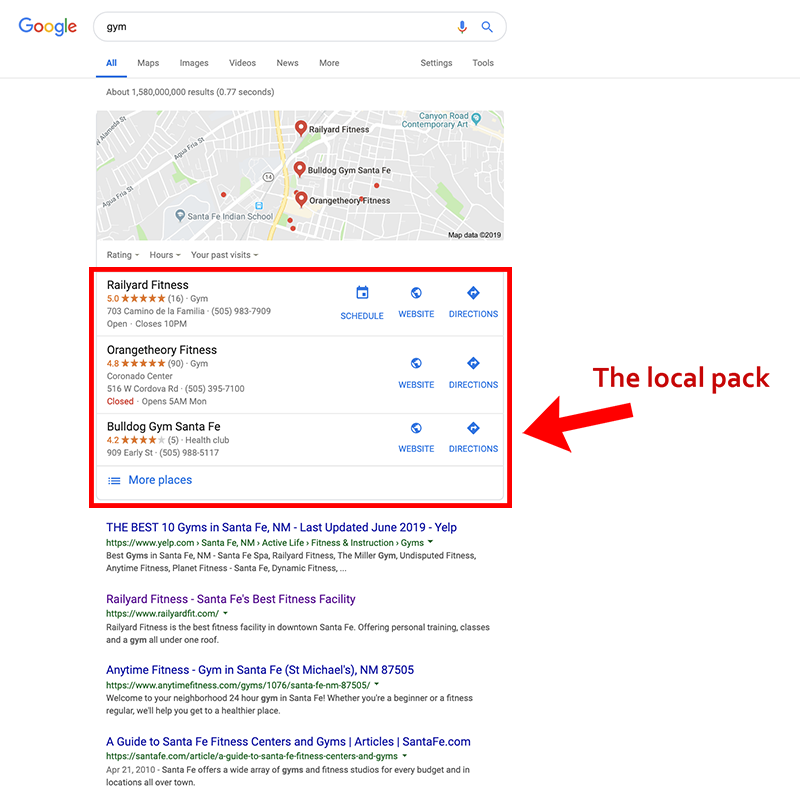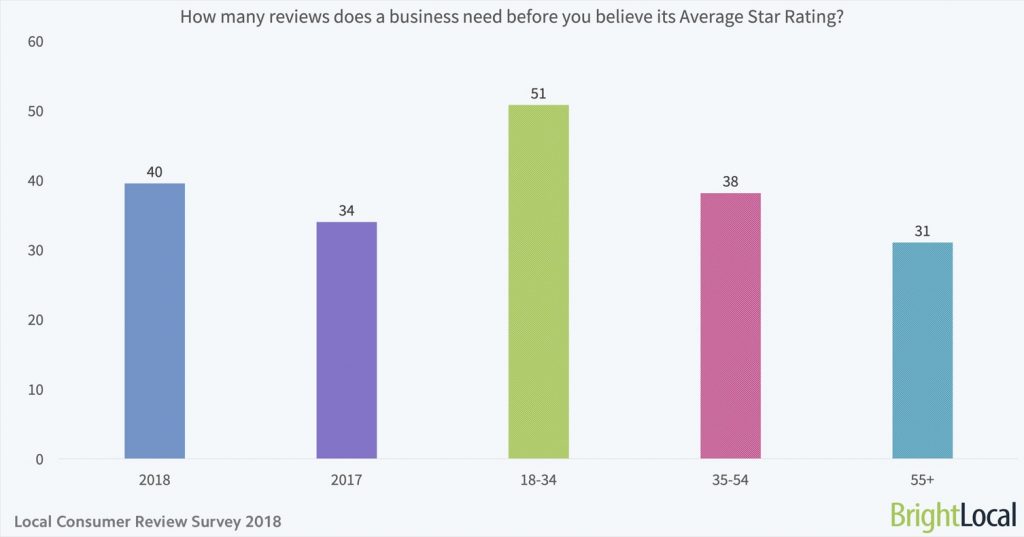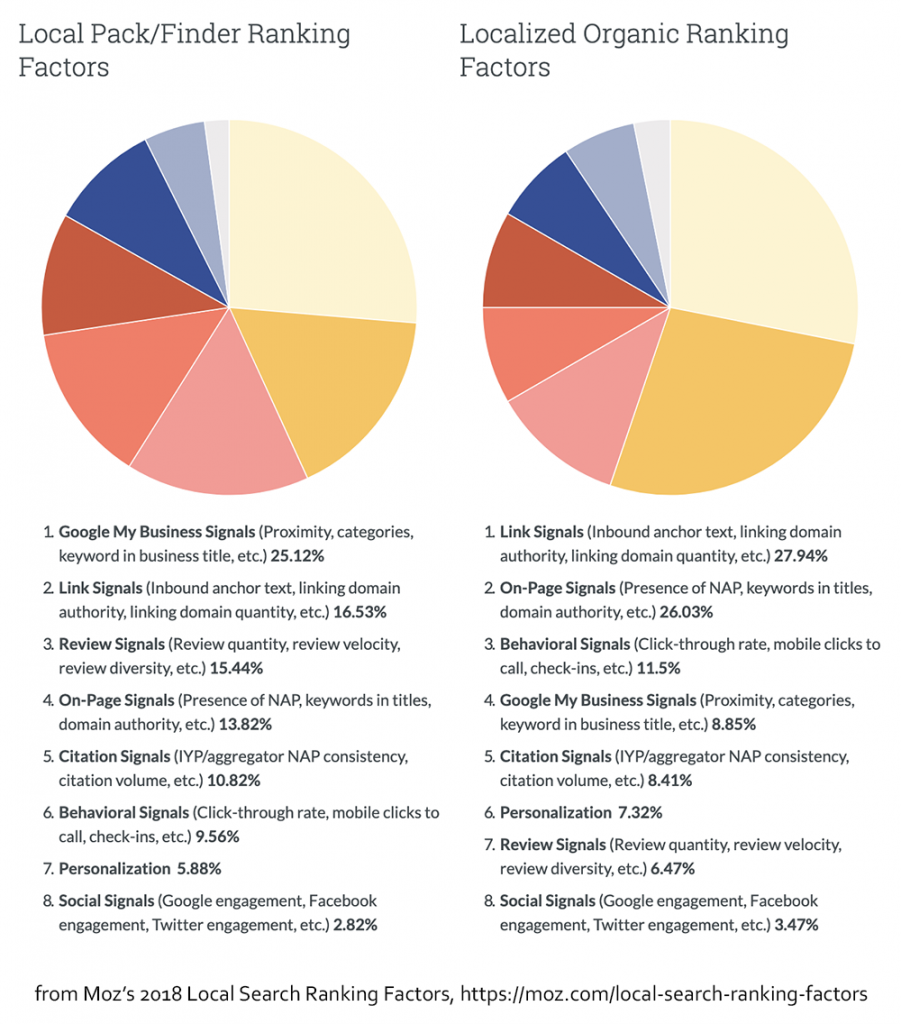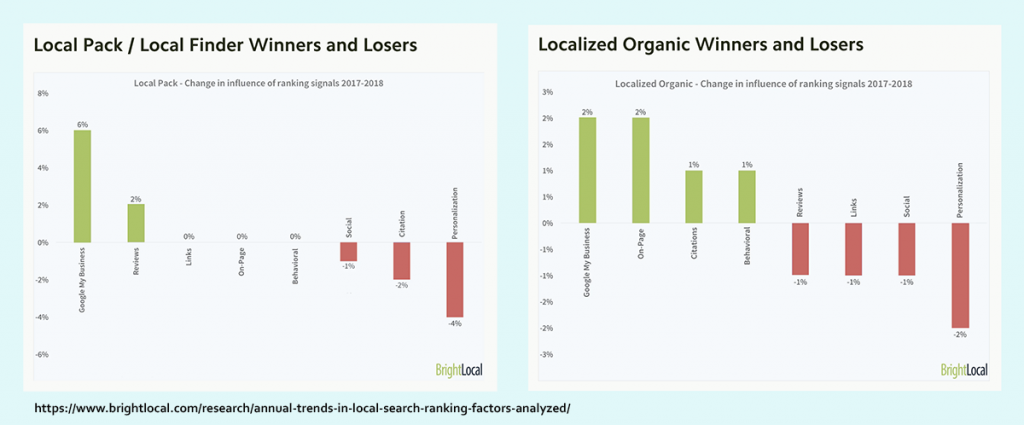Local search is a big deal. Even back in 2016, 46% of all searches on Google were local, and the percentage of local searches has probably grown considerably since then. There are more people using mobile devices, for one thing, and local searches are mostly mobile. Voice search has grown, too, which also leans towards local searches; an estimated 40% of voice searches have local intent.
If you’re a local business, this is good news. There’s ample free traffic available to attract new business with once you know how to do local SEO. And you aren’t competing against the whole world for that traffic – you’re mostly just competing against other local businesses.
But that doesn’t mean local SEO is easy. It takes work. In 2019, local SEO is actually a great deal like regular SEO, but with four key differences:
- The local pack
- Google My Business
- Reviews
- Local citations
The Local Pack
Unlike regular search, local searches trigger what’s called “the local pack.” It looks like this:
Google often changes how the local pack appears. For example: Notice how one of those listings lets you schedule an appointment? Sometimes segments of a review can also appear, or a business’s hours of operation. As of late 2018, businesses could even list which products they have for sale.
Whether or not your business appears in the local pack is influenced by several factors. First, by how much competition you have. Only three businesses appear in the local pack right now, though you can see more if you expand the section.
Google My Business Listings
The other major factor of whether your business will appear in the local pack is how well your Google My Business listing is filled out. And that, as mentioned above, is one other major difference between local and regular SEO.
Google My Business is currently free, though Google may offer a paid version of it soon. It’s one of the best free marketing tools available. It’s so valuable, in fact, that it’s common for small business owners to ask if they even need a website so long as they have a Google My Business listing.
While it might be tempting to skip all the work of having a website, we definitely recommend you have one. Even if “64% of consumers have used Google My Business to find contact details for local businesses,” you control your website. It’s one of the best assets any business can have.
But if you want more local search engine traffic to come to your site, you do need to completely fill out your Google My Business listing. You need to update it regularly with Google My Business posts – very much like you update your business’s Facebook page with posts.
Your Google My Business listing also needs to have your current business hours, excellent photographs, and even a few videos if you can manage it. The more professional and detailed your Google My Business listing is, the more likely you are to attract new business from it. And the more likely Google is to give your listing and your site some free traffic.
Customer Reviews
There’s one other super-critical component to your Google My Business listing: Customer reviews. These are one of the most important parts of your Google My Business listing, but they’re also one of the most important factors in whether or not your business makes that coveted local pack. A key part of how to do local SEO in 2019 is managing customer reviews.
Reviews are so critical for local businesses now that we could absolutely write a whole blog post about them. We could even write a whole book. But here’s the basics of what you need to know about reviews:
- The star rating for the reviews on a Google My Business listing or for an organic search result listing heavily influences whether people will click on the listing or not.
- Respond to reviews as often as you can. Even negative reviews.
- Studies have shown “consumers require an average 40 online reviews before believing a business’s star rating is accurate.
- Your business doesn’t need to have only five-star reviews. A few four-star reviews or even one lone two-star review won’t kill your business. It actually makes your reviews look more authentic if you have a few reviews that are less than five stars.
- Always ask happy customers to leave reviews. Some of them will follow through. Also, make it as easy as possible for people to leave reviews. Consider following up with your customers via email, and including a direct link in the email to where they can leave a review.
Local Citations
Local citations are any instance of a local business’s name, address, and phone number. They often include other information, but “NAP” data (name, address, and phone number) are the bread and butter of local citations.
Good local SEO requires that you have local citations on major sites (think places like Yelp and major directories). Your business’s citations must be consistent across these listings or Google and Bing will ding you.
There are several good resources online that list all the possible places your company citations could be listed, including this post published earlier this year.
If managing all those listings seems like a lot of work, you’re right. It is. But there are tools to make it easier. SEMRush’s local citations tool is probably the most popular. It’s available for the United States and Australia right now, but it will probably be rolling out to other countries soon.
Of course, there are plenty of other citation-management tools. And if you’re on a tight budget, it is possible to manage your citations with just a simple spreadsheet.
Local Search Ranking Factors: Two Studies
So those are the four core differences between regular and local SEO. But that’s not the end of your work for local SEO. Like regular SEO, local SEO in 2019 also requires having a well-optimized site, good content, a presence on social media, and several other things.
But before we get too deep into the weeds about all that, let’s look at what two major studies say are the most important factors for ranking well with local searches. There are hundreds of small things you can do to optimize your site and rank well, but it’s also possible to just focus on the most important factors and get excellent results. You can 80/20 your SEO. This is especially true with local SEO because you have fewer competitors than you would have if you were competing for non-local searches. Just getting the basics done will often put you ahead of local competitors.
Here is the summary chart from Moz’s 2018 Local Search Ranking Factors study. Notice how the local pack and the local search results are broken out separately? How your business ranks for those two locations is influenced by different ranking factors.
Both places in the local results (regular listings and the local pack) do use the same ranking factors, but they prioritize them differently. Still, if you’ve done any SEO at all, you’ll recognize most of the items on these two lists.
Here are a few key points that pop out:
- We’ve mentioned Google My Business listings. And there they are, the top factor for ranking in the local pack.
- But you’ll also need “link signals” – aka links. So link building matters as much for local SEO as for regular SEO.
- Same goes for “Behavioral Signals” – metrics Google uses to tell how much people like your site. Google needs to see that people like your site if they’re going to rank your site well.
- And then there are social signals. You need to have a decent social media presence now to do really well in search rankings, whether those searches are local or not.
Another local search ranking factors study from BrightLocal found similar things.
BrightLocal (like Moz) also found that having a great Google My Business listing matters most for the local pack. They say it matters most for the regular local listings, too. And they noted that reviews matter for the local pack. But BrightLocal found that personalization matters way less than it did last year, for both the local pack and the regular local listings. They also say the value of reviews, links, and social media for the regular local listings has been discounted.
So what does it all mean? It means there is some consensus on how to get a local site to rank in both the local pack and the local search results. But even two data-backed studies disagree on which ranking factors matter most.
And what does this mean for you and how you do local SEO? At the very least, these two studies show it’s critical to get your Google My Business listing up to par. The other thing these studies agree on is that personalization is important, but maybe not a top priority. They also agree that on-page optimization is really critical.
In practical terms, the key takeaway here may be to not focus too heavily on just one aspect of your local SEO. Make sure you’ve got at least the six core ranking signals addressed, and that you’ve regularly checking on them and trying to improve.
Those six ranking signals are:
- Google My Business
- Inbound links
- On-page SEO
- Reviews
- Citations
- Social Media
So just like for regular SEO, successful local SEO requires:
- Link building and high-quality inbound links
- A well-optimized website. This means (in part) including relevant keywords where they make sense, but not “overstuffing keywords” to the point that your site becomes spammy.
- Well-optimized title tags and meta description tags. These help the search engine bots understand what your pages are about. But these tags are also, in a sense, ad copy. The words in your pages’ title and meta description tags influence whether people click on your pages in the search results. You can either gain or lose a lot of free traffic based on how well-optimized and written those tags are.
- A social media presence. Both Google and Bing take into account how active a business is on social media.
Conclusion
Local search engine optimization in 2019 is a lot like regular search engine optimization. You need good content, good on-page SEO, a social media presence, well-optimized title and meta description tags, along with all the other SEO best practices.
But local SEO also requires a Google My Business listing and broad, accurate and updated local citations. It requires an ongoing customer review management program. Get all that right (or at least get it done better than your competitors) and there could be a nice stream of free, traffic to your site.
IMAGES
- Unsplash, Markus Spiske.
- Screenshot taken by the author, June 2019
- BrightLocal, 2018 Local Consumer Review Survey.
- Moz 2018 Local Search Ranking Factors Study.
- BrightLocal 2019 Local Search Rankings Study.







